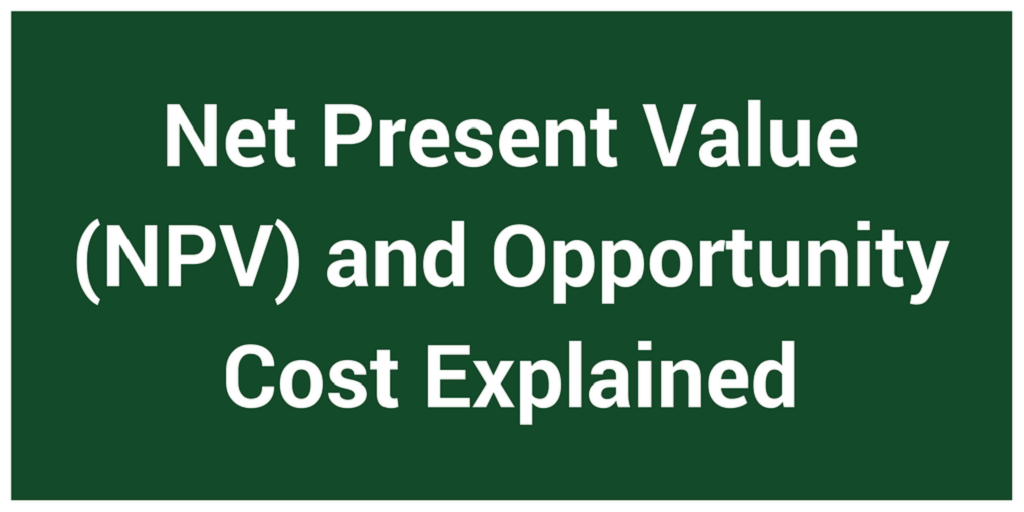Net Present Value (NPV) and Opportunity Cost Explained

As many of our small business clients are recovering strong this year, families and entrepreneurs are considering expansion of their thriving business. It is worth discussing how to figure out “if it’s worth it.” In financial terms, this is calculating Net Present Value (NPV), as well as Opportunity Cost.
The actual definition of Net Present Value is the current (right now, present, today) value of a series of future cash flows. As the lead dog, you also need to weigh the opportunity cost for that money. Meaning, if you don’t invest in this opportunity, what else would you do with the money?
Working With Net Present Value
In the real world, your instincts will help you through this see-saw gut check, but you may need to enlist the help of a financial consultant. For today, let’s go through a couple of examples, and define some of the math behind it.
Example One: Purchasing a Building
Imagine you just completed a large contract or job, need to expand for the next one, and have a pot of money just sitting around. Let’s pretend you have $250,000. When discussing a building ownership opportunity in Portland, Oregon, this isn’t enough money to buy anything but it’s certainly enough to put a good down payment on most things. We’re also going to assume you could get a loan, and it would be at some reasonable rate. We’re going to ballpark most of this, so just email me if you have specific questions. (I love math!)
Net Present Value: This is the process of evaluating the lease payments you could receive from the business. So, as the owner, you would take the dividend from the business, fund another LLC, and purchase the property within the LLC. Then, you would draw up a lease agreement for the building, and receive a second income as owner (which would likely be used to service debt in the early years).
Your NPV math includes the lease payments and any future increases. If you buy a big enough building, you could gather other tenants, too. When considering the NPV of ‘bonus the owner’ to buy the building (or buying it as an asset of the company), you need to also do this math for other ideas you have: upgraded equipment, additional human talent, and other spending ideas that can make you money. In an isolated environment, you simply choose the investment that makes you the most money, which backs into the highest NPV.
However, we all know that no decisions are made in an isolated environment (wouldn’t that be great?!?). So, the other consideration is Opportunity Cost.
What is Opportunity Cost?
Opportunity Cost is the balance of “what else would I do” with the money. In our building purchase example, maybe we need to hold a strong savings account, as we are weighted toward one large (maybe slow paying) customer. Maybe we are fast growing, so we want to fund it organically rather than debt. If either of these is true, do NOT spend that money! Other options for the money might include:
- Hiring exceptional talent
- ISO Certification
These things cost money and could bring us more dollars later (so could go into the NPV calculation). Other considerations for a building purchase might be:
- Do we want to expand into the land-owning business?
- Do we want to have tenants, or is it much easier to call our landlord when something goes awry?
This opportunity cost debate for our own bandwidth is much like the personal debate we all have when considering home ownership for our family.
Example Two: Buy a Struggling Competitor
Even as I type the example, I groan, knowing there is so much involved in buying a competitor. But, for the sake of a succinct blog, let’s assume the competitor wants to retire but has been working diligently (just like you). Their clients are happy, their systems are exactly the same, and all of their centralized talent wants to quit their jobs, so you can cherry pick the people you bring on, and don’t feel bad about laying anyone off. They have mint condition equipment, and a clean, happy, and accurate client database. They are close enough to you that you are the natural choice, anyway, and the manner in which you all work with clients is so similar, the customers hardly notice.
It could happen, right? (No way in the world!).
When debating this purchase (remember, NPV?), you need to consider not only the purchase price vs. the increase in sales you would get through additional sales and service to those clients, but you need to balance the opportunity cost of all these other questions I have just tossed out. If you are buying them, then I can promise that their business isn’t up to the level of yours (no matter what they may be telling you).
So, a blog about Net Present Value and it turns into a blog about Opportunity Cost. Go figure. Because it is almost always about more than math, for the same reason that when you take your family out to dinner on Friday, you don’t just choose the cheapest possible food.
Have you faced a decision like this in your business? What did you choose? Let me know in the comments!
About the Author Barb Fisher
Barb is the CEO of Fisher Bookkeeping, an outsourced bookkeeping consultancy that provides small businesses with a full-service financial department. Her favorite aspect of work is to break down the accounting to meaningful bits, so entrepreneurs can make a powerful difference in their own business. She's also a power lifter (squat: 215, DL: 270).
